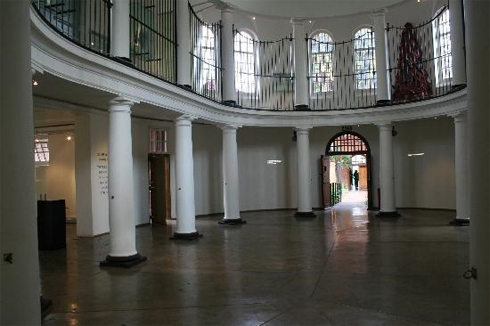Notes from class: 26th October 2010
The fourth week of the core course was taken by Annie Coombes, who plays Museum Cultures’ godmother to Fiona and Gabriel’s mum and dad. Though her set reading was in the realm of the holocaust and the modern art museum (texts from Andreas Huyssen’s Twilight Memories and James E. Young’s The Texture of Memory), Annie’s own work concentrates on museums that deal with traumatic national memories, specifically in South Africa and Kenya. Her presentation concentrated on South Africa, the trial of those responsible for the murder of the Gugulethu Seven, and the Women’s Jail on Constitution Hill in Johannesburg, now a museum.
Annie presented her key issues as:
- What means are available in the museum (or any other kind of commemorative project) for representing histories of violence, conflict and pain?
- How do you represent violence without reproducing it, re-subjecting its erstwhile victims to it again?
- Is there any way to avoid turning the pain of others into a spectacle?
- Is it possible to make traumatic experiences accessible to those who haven’t experienced them?
- Is it possible for us, as the spectators of other’s pain, to view it ethically, and avoid voyeurism?
On this last, Annie referenced Gayatri Spivak’s warning against privileged viewers’ narcissistic identification with the pain of the oppressed; in the context of exhibiting others’ pain, she also discussed James Allen’s exhibition of lynching postcards, Without Sanctuary.
She played a couple of films. Firstly, a clip from a demo tape by Barry Feinberg of testimony from women involved in the South African freedom struggle; secondly a pair of clips from Long Night’s Journey into Day, a documentary about the South African Truth and Reconciliation Commission, in which the mothers of the Gugulethu Seven first saw footage of their sons’ brutal murder, and then angrily confronted a former policeman about his involvement. She asked how a museum might similarly embody such contradictory, redemptive and personal remembrances of struggle.
Lastly, she presented some documentation of the Women’s Jail. The curatorial team that put together the museum/memorial environment here consisted of a historian, 2 (male) artists and a former prisoner. There are no reconstructions; in the grounds there are photos on glass of some of the women who were imprisoned there. Some of the isolation cells contain more elaborate installations, featuring video testimony and objects chosen by former prisoners as symbols of their struggle and incarceration (a wedding dress one never got to wore, for example). Issues of (sexual) abuse in the jail are dealt with more obliquely; much is made, for instance of underwear, and the denial of adequate sanitary protection; but these also stand proxy for darker, unmentioned crimes.
The issue of personal identification in the museum environment was again raised: at the Apartheid Museum, for instance, one is offered the choice to enter as black or white (a choice never possible in the history of apartheid); the opportunity to carry the card of a holocaust victim at the US Holocaust Memorial Museum was also discussed (though my notes show no mention of exhortations to identification) as a strategy against the anonymising force of the death camps themselves.
A question came up at the end about how one might address the humanity of the perpetrators of crimes like apartheid. It struck me as more germane to wonder whether memorials to struggle can only be constructed when the struggle has been won. The testimony of women who put everything on the line for their role in the struggle is made both moving and worthy of memorial by the fact that the ANC prevailed. How could we construct a memorial to the struggle of the Weather Underground; how could we present the experience of Cathy Wilkerson, who similarly threw her life into a struggle, but who finally came to the conclusion that she was wrong? Where is the museum of lost causes?
